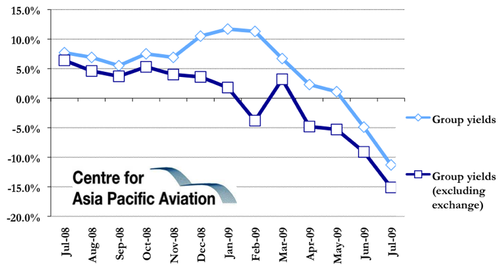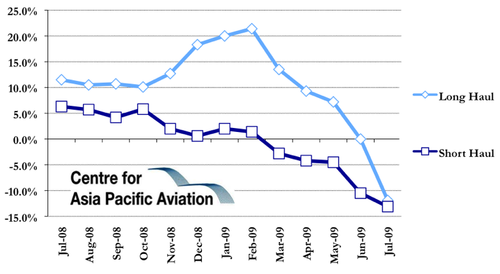Air New Zealand's yields continue to tumble in July, with no end in sight
Air New Zealand's yields continued to crumble in Jul-2009, with Group yields slumping 11.3% year-on-year, following a 4.9% reduction in Jun-2009, despite significant capacity cuts.
Air New Zealand Group yields including and excluding exchange rate effects (% change year-on-year): Jul-2008 to Jul-2009
Air New Zealand's group yields, excluding exchange rate effects, were also down by double digits, slumping 15.1% last month, following a 9.1% reduction in Jun-2009, and marking a further serious deterioration for the national airline.
Jetstar entry and subsequent fare wars hammer short-haul yields
Air New Zealand's short-haul yields took a hammering last month following Jetstar's entry in the domestic market. Air NZ's short-haul yields (which includes trans-Tasman services) fell 13.1% in the month, following a 10.5% reduction in Jun-2009.
Long-haul yields down by double digits after a strong 2008
Long-haul yields were also down year-on-year for the first time in over 12 months, by 11.9% in Jul-2009. Long-haul yield growth peaked at 21.4% six months ago in Feb-2009. The fall since then has been spectacular.
Last month's reduction was off double-digit growth in the corresponding period in 2008. According to the carrier, yields were higher in 2008, partially due to fuel price related increases, which have reduced as fuel prices has decreased.
This carrier is likely headed for another month of double-digit yield reductions in Aug-2009.
Air New Zealand short- vs long haul yields (excluding exchange) (% change year-on-year): Jul-2008 to Jun-2009
Load factors fall despite capacity reductions
In addition to falling yields, Air New Zealand also experienced declining load factors in the month, as the carrier's 9.6% capacity reduction failed to match the lower passenger demand.
Group passenger load factor decreased by 3.2 ppts (domestic load factor down 1.8 ppts with Tasman/Pacific load factors increasing 2.0 ppts), although this was against a strong Jul-2008, in which the carrier benefited from the World Youth Day in Sydney, which increased passenger demand in the month.
Swine flu creates further pressures on international demand
In Jul-2009, Air New Zealand transported 1.1 million passengers, an 8.4% reduction, as short haul passenger numbers declined 6.9%, and long haul passenger numbers slumped by 16.9%.
Influenza A (H1N1) continued to soften demand from Japan with passenger numbers on Asia/Japan/UK routes down 24.2% year-on-year. The carrier reduced capacity on these routes by 16.2%, by combining flights from Osaka and Tokyo into a single flight and the down gauging to a B777-200 on the Hong Kong-London service.
Air New Zealand and Qantas welcomes Government trans-Tasman Plan
Meanwhile, Australian and New Zealand Governments announced a new trans-Tasman agreement to improve customs processing for Australian and New Zealand passengers travelling between the two countries.
The agreement includes the establishment of the SmartGate passenger clearance system, electronic passport checks, direct exit paths and improved baggage screening.
Air New Zealand welcomed the agreement, stating it is now also working with the NZ Government to introduce check-in kiosks for trans-Tasman travel. Similarly, Qantas stated the changes to existing arrangements would provide some economic benefits through increased business and leisure travel and tourism.
The move is expected to place additional downward pressure on fares.
Jetstar New Zealand success leads to further NZ domestic expansion
Air New Zealand would also be concerned by Jetstar's statement this week that it has an "active pursuit" of future growth options within the New Zealand market.
Jetstar, which stated it is pursuing future growth options with receptive airport partners in New Zealand", plans to rapidly expand its New Zealand presence, moving more A320s into the domestic market.
The statement was made after the carrier announced an underlying profit before tax (excluding start-up costs) for its first full month (Jul-2009) of domestic New Zealand operations. Passenger seat factor was 78% in Jun-2009 and in excess of 80% in Jul-2009.
The Qantas subsidiary's domestic New Zealand business now operates over five routes between Auckland, Christchurch, Wellington and Queenstown and comprising 84 weekly return services.
Will Pacific Blue target regional destinations with E190s?
Meanwhile, Virgin Blue's offshore arm, Pacific Blue, is now well-established domestically in New Zealand's domestic market, operating to six points in New Zealand, including Auckland, Hamilton, Wellington, Christchurch and Queenstown. The carrier also commenced service to Dunedin in Jul-2009, marking the first real challenge to Air New Zealand's existing monopoly on regional routes.
Pacific Blue also commenced test flights for its new E190s for international regional and New Zealand services in May-2009, with the carrier then stating that the E190 presents "other tempting opportunities to introduce further competition".
The E190s are smaller than the B737s currently operated by the carrier on the routes, but larger than the turbo-props operated by Air New Zealand across its regional network. However, Pacific Blue has not yet disclosed a date for the commencement of E190 revenue services in New Zealand.
Outlook: Competition to intensify
Jetstar's aggressive push on the Tasman and in domestic New Zealand will not go away, as the carrier made clear this week. Meanwhile, Pacific Blue continues to fight to maintain a presence domestically, with the possibility of utilising Virgin Group Embraer regional jets to access more regional points in New Zealand. All of this will continue the downward pressure on yields.
Air NZ is due to report its 2008/09 financial results on 27-Aug-2009, with analysts forecasting a net profit ranging from NZD65 million to NZD113 million - down from last year's NZD218 million.

